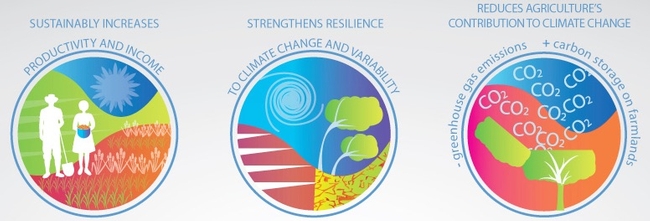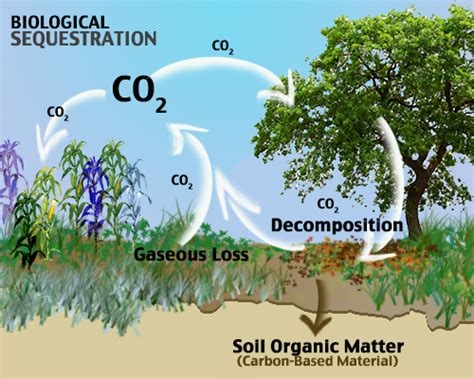What exactly is climate smart agriculture? The Food and Agriculture Organization of the United Nations coined the term climate smart agriculture as “an approach that helps to guide actions needed to transform and reorient agricultural systems to effectively support development and ensure food security in a changing climate.” In short, climate smart agriculture addresses how to manage agricultural systems to meet the nutritional needs of a growing population while both building resiliency to climate change and using agriculture as a solution to our climate crisis.
To be effective, climate smart agriculture must meet three main objectives:
1) Increase agricultural productivity and incomes;
2) Adapt to and build resiliency to climate change; and
3) Reduce greenhouse gas emissions
Climate smart agriculture addresses the risks that agricultural production faces under a changing climate, underscores agriculture's role in solving climate change, and focuses on the importance of intensification of agriculture required to feed a global population.
Agriculture and working lands play a significant role in climate change. According to the EPA's recent inventory, agricultural management practices contribute 8.4% of the United States' greenhouse gas (GHG) emissions. Interestingly, and encouragingly, agriculture can also act as a greenhouse gas sink by removing atmospheric carbon and storing it in plant tissue and soils. Through effective management, agriculture provides a significant solution to climate change.
California's agricultural industry is at extreme risk to the impacts of climate change. Changes in temperatures, precipitation patterns, extreme weather events, and water availability all pose a threat to the viability of agricultural production. Warming temperatures throughout the state will result in a decline of winter chill hours, increased water demand by crops, and the promotion of various pests. Projections show an increased tendency of heat wave events and an increase in duration and intensity of drought. In addition, California expects to see earlier snowmelt, resulting in increased flooding and a decrease in year-round water availability. This is a doom and gloom scenario we can look forward to unless we decide to act today to plan for tomorrow.
The California Department of Food and Agriculture administers 3 programs to help farmers, ranchers, and dairy operators implement climate smart agriculture practices:
-
The State Water Efficiency and Enhancement Program (SWEEP) encourages farmers to install more efficient irrigation systems that decrease their water consumption as well as their greenhouse gas emissions. You can apply for a SWEEP grant for up to $100,000.
-
The Alternative Manure Management Program (AMMP) awards funds - up to $750,000 - to livestock producers who decrease their methane emissions by changing the way that they manage manure.
-
The Healthy Soils Program takes a two-pronged approach. For the Incentives Program, there is $75,000 available per project. There is also the option to coordinate with your local resource conservation district or university on a Demonstration Project, which can award up to $250,000 for the research and demonstration of new healthy soils practices. The Healthy Soils Program encourages the implementation of conservation agriculture techniques that decrease erosion and greenhouse gas emissions, like cover cropping, compost, crop rotation, and mulching.
In October 2018, CDFA and the University of California Agriculture and Natural Resources agreed to work together to enhance access to information and technical assistance for the state's climate smart initiatives. The ten Community Education Specialists scattered throughout the state can help growers and producers with the grant application process, at no cost to the farmer.
Keep an eye out for future announcements about grant deadlines - they all passed in March and April 2019 but should reopen within the next year, pending further funding.
For more information about these programs and for help applying for these grants, contact your local Community Education Specialist:
| County | Contact | Phone | |
| Mendocino | Britta Baskerville | blbaskerville@ucanr.edu | (707) 463-4158 |
| Caddie Bergren | cmbergren@ucanr.edu | (209) 385-7403 | |
| Glenn | Dana Brady | dmbrady@ucanr.edu | (530) 517-8187 |
| Yolo, Solano & Sacramento |
Emily Lovell | ejlovell@ucanr.edu | (530) 405-9777 |
| Santa Cruz | Valerie Perez | valperez@ucanr.edu | (831) 763-8028 |
| Kern | Shulamit Shroder | sashroder@ucanr.edu | (661) 868-2168 |
| Alli Rowe | amrowe@ucanr.edu | (805) 645-1464 | |
| Esther Mosase | enmosase@ucanr.edu | (605) 592-0275 | |
| Imperial | Kristian Salgado | kmsalgado@ucanr.edu |
(442) 265-7700 |
Climate smart agriculture encompasses management practices that increase soil carbon sequestration, reduce greenhouse gas emissions, improve yields and efficiencies, and promotes climate resilience. The California Department of Food and Agriculture (CDFA) supports three funding opportunities in climate smart agriculture: the Healthy Soils Program, the State Water Efficiency & Enhancement Program, and the Alternative Manure Management Program.
In a collaborative partnership, CDFA and UC Agriculture and Natural Resources have teamed up to support 10 community education specialists throughout the state to provide technical assistance and outreach for the climate smart agriculture programs.

